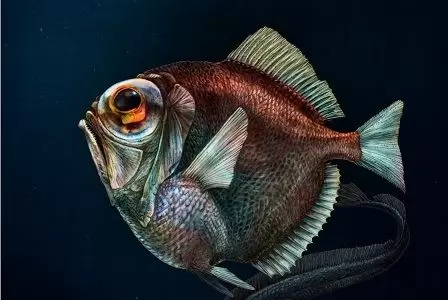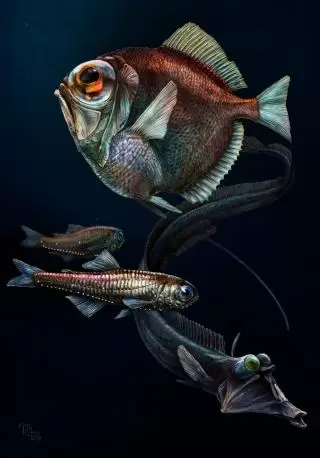
Views: 108
– Humans, along with many other mammals, must make do with four different light-sensitive proteins in the rods and cones of our retinas. However, fish species living in the deep sea can have up to 40 different proteins aiding their vision. This means that they most likely see some sort of color where humans would only see pitch-black darkness.
Courtesy Uio by Bjarne Røsjø – Humans and many other vertebrates have three different light-sensitive proteins in the so-called cones of our retinas, and one other light-sensitive protein in the rods. The proteins in our cones work best under good light conditions and enable us to see color, while the proteins in our rods work under weaker light conditions to give us a black and white picture of our surroundings.

However, some deep-sea fish, living in eternal darkness, are better equipped than humans when it comes to their sense of vision. Researchers at the University of Oslo (UiO), along with colleagues from several other countries, have shined a light on the vision of 101 fish species, using genomes as a starting point. Most of the species had only one light-sensitive protein in their rods – just like vertebrates. However, 13 of them were deep-sea fish species with several genes and light-sensitive proteins in addition, a fact that was previously unknown.
“These extra proteins are membrane proteins that are most likely specially adapted to register the weak light found in the deep sea,” says Professor Kjetill S. Jakobsen at UiO’s Centre for Ecological and Evolutionary Synthesis (CEES).
He is one of the authors behind the scientific article published recently in the American journal Science, one of the most prestigious research journals in the world, along with a reference to the article on the cover.
“The silver spinyfin Diretmus argenteus holds the record, with a total of 38 different light-sensitive proteins in the rods, and two in the cones. The proteins in the rods react to different wavelengths, and this indicates that the rods give this fish some kind of color vision. This means that this fish can see color by using the rods that only give us humans black and white vision,” adds Jakobsen.
A weak blue light

The deep-sea fish that were studied live between 200 and 1500 meters below the sea surface, in a strange world where the majority of daylight has been filtered away by the water masses. The only light reaching down to these depths from above is a weak blueish light with wavelengths between 400 and 500 nanometers.
Yet the deep sea is not completely dark, as algae, fish, jellyfish, etc. living in its depths emit their own light – a phenomenon known as bioluminescence. The light from these creatures is typically in the range of 420 to 520 nanometers. At depths greater than about 200 meters – depending on water quality – the light from bioluminescence will be stronger than the faint daylight that makes it from the surface.
The silver spinyfin, along with the other deep-sea fish that have several different pigments in their retinas, are probably capable of seeing both the daylight from above and the light emitted at slightly different wavelengths from different living creatures.
“This work actually started several years ago, when a group of researchers here at CEES planned to map the evolutionary relationship between different fish species by studying their genes. It was through that project that we discovered, among other things, that codfish lack a central part of the immune system. Then we started to look at these deep-sea fish, because we wondered how much they could actually see in the darkness of the deep,” says Jakobsen.
“Now we have discovered that 13 deep-sea fish species from three different bony fish groups have several genes previously unknown to us. These genes enable the fish to expand their repertoire of light-sensitive proteins, or rod opsins, which was also previously unknown. Rod opsins react to slightly different wavelengths in the blueish light found in the deep sea, and therefore we believe that the fish see something comparable to color,” he elaborates.
Genes found first
The CEES researchers did not start their search by specifically looking for pigments in the rods and cones of deep-sea fish: Instead, they started by investigating all the genes in the deep-sea fish genomes. This is how they discovered an array of genes which contained “recipes” for many different light-sensitive pigments. More specifically, these genes had variations in a special DNA segment that regulates which color/wavelength the proteins are sensitive to.
“But it wasn’t enough to show that the fish had many different genes, because genes can be in the genome without being expressed. That’s why we took out the actual genes and put them into bacteria, which started to synthesize the different proteins. And then we investigated which wavelengths the proteins absorbed,” says Jakobsen.
The silver spinyfin Diretmus argenteus is the undisputed record holder when it comes to light-absorbing pigments, but the researchers also found several other species that were well equipped with rod opsins.
“The glacier lantern fish Benthosema glaciale has five different rod opsins, while the strange tube-eye Stylephorus chordatus has six different types. We also investigated some relatives of the record holder, and found up to 14 rod opsins,” says Martin Malmstrøm.
Malmstrøm was a postdoc and a key scientist in the work to pick out the genes that the researchers would later focus on. He is now a project leader at the Norwegian Scientific Committee for Food and Environment.
Professor Jakobsen underscores that the researchers cannot know for sure that the fish see color in the deep sea.
“We could only say this with absolute certainty if we attached electrodes in the brain of these fish and analyzed their brain waves while they swam around. It’s doubtful that this could be done. Still, we are fairly sure that both the genes and the rod opsin variants are active. If the fish received no practical benefit from the ability to see colors of different wavelengths, then they would probably have lost the ability to do so over time,” analyzes Jakobsen.
A doubling of genes
The new analyses show that the gene variants of the deep-sea fish resulted from a series of gene duplications that may have started around 50 million years ago. Such duplications can occur spontaneously in nature, and the ancestor of deep-sea fish probably had one gene for rod opsin production. Duplication means that an area of DNA is doubled, and in this way the offspring can suddenly have two versions of the same gene. These genes can then change – mutate – independent of one another, and in this way the fish can have rod opsins that react to slightly different light frequencies.
“We know from before that once a gene is duplicated it is easier for further duplications to occur. That’s why we don’t usually find only two copies of the same gene when we analyze species. It’s more common to find several copies,” postdoc Ole Kristian Tørresen points out.
Betting on sight
Toothed whales (Odontoceti) and bats are examples of mammals that have developed a sensory organ using echolocation in order to orient themselves in the pitch-black darkness. Echolocation entails the animal sending out a series of sound waves that are reflected back when they hit something, for example a fish or something else.
“But these deep-sea fish have evolved their sense of sight instead, so that they can see relatively well under conditions that we humans would experience as pitch-black darkness. One can only be impressed by nature’s and evolution’s way of finding solutions that work,” comments Jakobsen.
An enormous amount of work lies behind the new scientific article in Science. The actual article is only five A4 pages, but the researchers have also used ca. 100 pages in an attachment to explain the details of how they proceeded. There were challenges across multiple disciplines; for example, getting hold of a sufficient number of deep-sea fish species was a project in itself. Therefore, it was necessary to have a multidisciplinary team of evolutionary biologists, molecular biologists, fish ecologists, marine biologists, and sight physiologists, in order to complete the study.
THIS IS HOW SIGHT WORKS
Photons hit the eye’s retina, which is equipped with a large number of light receptors (rods and cones).
- Some of the photons hit a central chemical bond in a light-sensitive protein. If the photon has the correct wavelength and frequency, it can trigger a small structural change in the protein.
- The structural change triggers a long chain reaction which eventually leads to a small electrical signal being sent to the visual cortex.
- Cones in the human retina register light with wavelengths between ca. 380 nanometers (violet) and ca. 750 nanometers (red).
- Rods are most sensitive to light with a wavelength of around 500 nanometers.
This text was translated from Norwegian by Sari C. Cunningham
Contact: Professor Kjetill S. Jakobsen, CEES og UiO’s Department of biosciences
The scientific publication: Musilova, Cortesi et al.: Vision using multiple distinct rod opsins in deep-sea fishes. Science, published 9 May 2019.
Related article: New data factory to support marine innovation
Leave a Reply